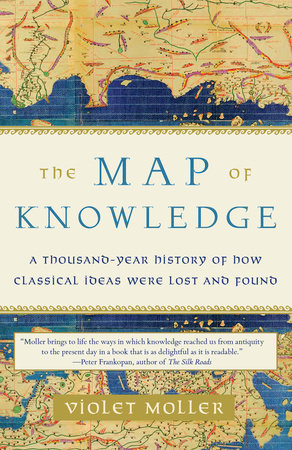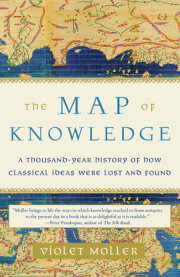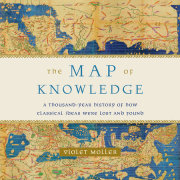PrefaceIn early 1509, the young artist Raffaello Sanzio (1483–1520) began painting a series of frescoes on the walls of Pope Julius II’s private library, deep inside the Vatican. Next door, in the Sistine Chapel, Raphael’s great rival, Michelangelo, lay on his back on a huge scaffold, hundreds of feet in the air, painting onto the ceiling a monumental image of God giving life to Adam. The Renaissance was in full swing in Rome and, under the patronage of Pope Julius, the great city was being returned to the glory of its ancient imperial past. Raphael’s frescoes on the four walls of the Stanza della Segnatura illustrated the four categories of books that were shelved below them: theology, philosophy, law and poetry. In the philosophy fresco, which we now call
The School of Athens, Raphael painted three huge vaulted arches receding into the distance, with statues of the Roman gods Minerva and Apollo on either side and broad marble steps leading down to a geometrically tiled floor. The architecture is decidedly Roman—bold, imperious, monumental—but the culture and ideas represented by the fifty-eight figures carefully grouped across the painting are emphatically and almost without exception Greek; it is a celebration of the rediscovery of ancient ideas that were central to the intellectual milieu of sixteenth-century Rome. Plato and Aristotle stand in the very centre, under a huge arch, silhouetted against the blue sky, which Plato points up to, while Aristotle gestures to the earth below him, neatly representing their philosophical tendencies—the former’s preoccupation with the ideal and the heavenly, the latter’s determination to understand the physical world around him. The full scope of ancient philosophy as inherited by Italian humanism is triumphantly rendered in glowing colour.
No one knows exactly who all the other figures in the fresco are, and arguments over their identities have kept scholars occupied for centuries. Most people agree that the bald man in the front right, busy demonstrating geometrical theory with a compass, is Euclid, while the crowned man next to him, holding a globe, is certainly Ptolemy, who at this point was far more famous for his work on geography than astronomy.* All the figures identified lived in the ancient world, at least a thousand years before Raphael began painting the fresco—except for one. On the left of the painting, a man wearing a turban is leaning over Pythagoras’ shoulder to see what he is writing. He is the Muslim philosopher Averroes (1126–1198)—the single identifiable representative of the thousand years between the last of the ancient Greek philosophers and Raphael’s own time, and the single representative of the vital, vibrant tradition of Arab scholarship that had flourished in this period. These scholars, who were of various faiths and origins, but were united by the fact that they wrote in Arabic, had kept the flame of Greek science burning, combining it with other traditions and transforming it with their own hard work and brilliance—ensuring its survival and transmission down through the centuries to the Renaissance.
I studied Classics and history throughout my time at school and university, but at no point was I taught about the influence of the medieval Arab world, or indeed any other external civilization, on European culture. The narrative for the history of science seemed to say, “There were the Greeks, and then the Romans, and then there was the Renaissance,” glibly skipping over the millennium in between. I knew from my medieval-history courses that there wasn’t much scientific knowledge in Western Europe in this period, and I began to wonder what had happened to the books on mathematics, astronomy and medicine from the ancient world. How did they survive? Who recopied and translated them? Where were the safe havens that ensured their preservation?
When I was twenty-one, a friend and I drove from England to Sicily in her old Volvo. We were researching Graeco-Roman temples for our third-year dissertations. It was a great adventure. We got lost in Naples, hot in Rome, we were pulled over by the police and asked out on a date, we gaped at Pompeii and ate milky balls of buffalo mozzarella in Paestum, and finally, after weeks on the road and a short ferry trip across the Straits of Messina, we arrived in Sicily. The island immediately felt different from the rest of Italy: exotic, complicated, compelling. Its layers of history enveloped us; the marks left by succeeding civilizations, like strata in a rock face, were striking. In Syracuse Cathedral, we saw the columns of the original Greek Temple of Athena, built in the fifth century bc, still standing 2,500 years after they were erected. We learned how the cathedral had been converted into a mosque in 878, when the city came under Muslim control, and how it became a Christian church again two centuries later, when the Normans took power. It was clear that Sicily had been a meeting point for cultures over hundreds of years, a place where ideas, traditions and words had been exchanged and transformed, where worlds had collided. The focus of our trip was the relationship between Greek and Roman religion and architecture, but the contribution of later cultures—Byzantine, Islamic, Norman—was remarkable. I began to wonder about other places that had played a similar role in the history of ideas, and how those places had developed.
These questions resurfaced when I was researching my PhD on intellectual knowledge in early modern England, viewed through the library of Dr. John Dee (the man Elizabeth I called her philosopher). A strange and captivating character, Dee was my constant companion for several years. He took me on an unforgettable journey through the intellectual world of the late sixteenth century. During his extraordinary career, he amassed the first truly universal collection of books in England, helped plan voyages of discovery to the New World, initiated the concept of a British Empire, reformed the calendar, searched for the philosopher’s stone, attempted to conjure angels and travelled all over Europe with his wife, servants, several children and hundreds of books in tow. He also wrote extensively on a wide range of subjects: history, mathematics, astrology, navigation, alchemy and magic. One of his most significant achievements was helping to produce the first English translation of Euclid’s
Elements, in 1570. But where had this text been and who had looked after it in the 2,000 years between Euclid writing it in Alexandria and Dee publishing it in London? Studying the catalogue Dee made of his library in 1583, I noticed that a great many of his books, especially those that touched on scientific subjects, were written by Arab scholars. This tied in with the things I had seen in Sicily and gave me a taste of what had been going on in the Islamic world in the Middle Ages, expanding my view of history beyond the traditional Western scheme. I began to realize that the history of ideas is not constrained by boundaries of culture, religion or politics, and that, in order to fully appreciate it, a more far-reaching approach is necessary.
These ideas remained at the back of my mind, gradually crystallizing into a plan for a book that would follow ancient scientific ideas on their journey through the Middle Ages. As it is an enormous subject, I decided to concentrate on a few specific texts and plot their progress as they passed through the major centres of learning. With my focus on the history of science and, more precisely, “the exact sciences,” three subjects were clearly delineated: mathematics, astronomy and medicine. Within them, three geniuses stand out: in mathematics, Euclid; in astronomy, Ptolemy and, in medicine, Galen. Euclid and Ptolemy both wrote comprehensive surveys of their subjects—
The Elements and
The Almagest—but Galen was a more complex proposition. He wrote hundreds of texts, so I decided to concentrate on those that formed the medical curriculum in Alexandria, in addition to the general areas of anatomy and pharmacology. All three of these remarkable men defined the structure and content of their individual subjects. They created the framework within which future scholars would work for hundreds of years. Many of the theories of Ptolemy and Galen have since been disproved and replaced, but their influence and legacy is incontrovertible. Galen’s theory of the humours still survives in traditional Tibetan medicine and also in modern complementary medicine. Ptolemy’s survey of the fixed stars endured, as did his “idea that the physical world is dependable and can be understood with mathematics.”
In contrast, Euclid’s
Elements has stood the test of time, almost in its entirety. It was still being taught in classrooms in the twentieth century, and the geometrical theories it contains remain as true and relevant today as they were in the fourth century bc. The same applies to Euclid’s demonstrative method, which uses a concise technical vocabulary, suppositions and proofs (diagrams), and which has remained a template for scientific writing ever since. Euclid, Galen and Ptolemy pioneered the practice of science based on observation, experimentation, accuracy, intellectual rigour and clear communication—the cornerstones of what is now known as “scientific method.”
When I began to research in earnest, I was surprised how neatly the story unfolded in front of me. The year 500 was an obvious moment to begin— a time when the intellectual traditions of antiquity were evolving into those of the Middle Ages, when scholarship was entering a different era. Subsequent chapters each centre on a different city, first of all doubling back to Alexandria to see when and how the texts were written. From here, they were dispersed across the Eastern Mediterranean to Syria and Constantinople, where they remained until the ninth century, when scholars from the new city of Baghdad, capital of the vast Muslim Empire, began seeking them out to translate them into Arabic and use the ideas contained in them as the foundation for their own scientific discoveries. Baghdad was the first true centre of learning since antiquity, and over time it inspired cities across the Arab world to build libraries and fund science. The most important of these was Córdoba, in southern Spain, ruled over by the Umayyad dynasty, under whose patronage the works of Euclid, Ptolemy and Galen were studied and where their ideas were questioned and improved upon by generations of scholars. From Córdoba, they were taken to other cities in Spain and, when the Christians began to reconquer the peninsula, Toledo became an important centre of translation and the place where they entered the Latin, Christian world.
This was the major route the texts took, but there were other places in the Middle Ages where ancient Greek, Arabic and Western culture collided. Salerno, in Southern Italy, was a place where medical texts (in Arabic, but derived from Galen) were taken from North Africa and translated into Latin, and, as a result, Salerno became the centre of European medical studies for centuries, playing a vital role in the dissemination of medicine. Then, in Palermo, Ptolemy and Euclid take centre stage from Galen, as scholars translated copies of
The Elements and
The Almagest directly from Greek to Latin, bypassing the Arabic versions in the hope of achieving greater accuracy. The three divergent strands came together in Venice, where manuscripts began to arrive in the last half of the fifteenth century, ready to be printed for the first time.
There were, of course, other cities I could have included, but sticking to those in which copies of the key texts were studied and translated seemed the best way to avoid getting lost in this huge story. Choosing them threw up some interesting questions about what constitutes a centre of learning. Constantinople was a major repository of ancient texts, but not somewhere that science was studied with any degree of originality or rigour. Nor was it a place where translation (and therefore transmission) happened on any kind of scale and, for these reasons, it only features in a supporting role—the place to which scholars and caliphs came when searching for copies of Euclid, Ptolemy and Galen. The city on the Golden Horn might have taken over from Alexandria in terms of power and status, but it was a pale shadow when it came to scientific learning— a centre of preservation rather than innovation. Toledo, Salerno and Palermo were the places where Arabic culture came into closest contact with Christian Europe, but there was also a degree of exchange in Syria during the Crusades. I have not discussed this in much detail, however, because there is no evidence that
The Elements,
The Almagest or Galen’s major works were among the books translated there.
While the underlying narrative for this story was easy to follow, finding a way through the dense, tangled undergrowth of manuscript history was not. Because they were so significant, several editions of each text were produced—teasing out their relationship to one another and finding a clear path through was often challenging. Until the introduction of the printing press, every single text was copied out by hand, so each one was different, with its own peculiarities and mistakes. The study of complex textual traditions is a discipline all of its own within history, and not one to which I can claim expertise. In order to stay true to the narrative, I have had to be selective and produce simplified versions of the rich manuscript histories of these great books.
For me, the history of ideas has always been the most fascinating aspect of our past. Discovering how people approached the fundamental questions about our planet and the universe, how they passed their theories on to future generations and expanded the frontiers of intellectual knowledge, is compelling. Much of this type of history is obscured in erudite books on the shelves of research libraries, but this should not be the case. By taking a broad view and writing about the characters and stories, rather than focusing on the scientific content and historical minutiae found in academic books, it is possible to bring the history of ideas to life. For example, understanding Ptolemy’s model of the universe is above and beyond anyone without detailed knowledge of astronomy, but appreciating its importance and following its progress is both meaningful and fascinating. Doing so takes us on a sweeping journey through the Middle Ages, zooming in on certain places at certain moments to discover exactly how and why scientific ideas were transmitted and transformed. In this way, the boundaries of the traditional Western historical narrative are expanded by shining a light on the profound contribution of both the Islamic world and medieval Christian scholars, filling in the millennium between “the Romans” and “the Renaissance.” This made it possible to include theories from other cultures which were gradually incorporated into the canon of mathematical, astronomical and medical thought. Ideas like the Hindu-Arabic numerals and positional notation system that came from India, via the Muslim Empire, and are used all over the world today.
When you step back and look at history from a wider angle, the intricate web of connections between different cultures comes into focus, giving us a broader, more nuanced and ultimately more vivid view of our intellectual heritage.
Copyright © 2019 by Violet Moller. All rights reserved. No part of this excerpt may be reproduced or reprinted without permission in writing from the publisher.






